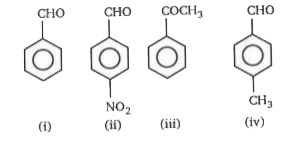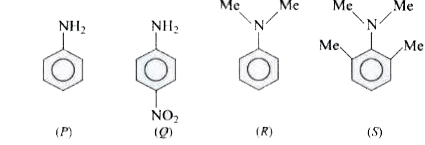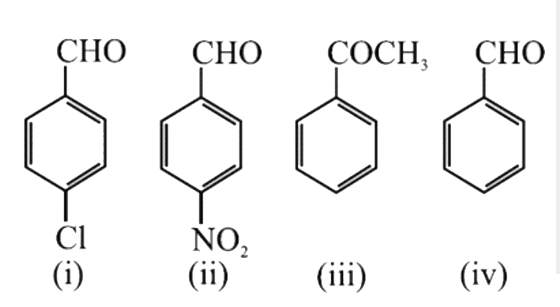Arrange the following compounds in increasing order of their reactivity in nucleophilic addition reactions.
Ethanal, Propanal, Propanone, Butanone
Butanone lt Propanone lt Propanal lt Ethanal
Propanone lt Butanone lt Ethanal gt Propanal
Propanal lt Ethanal lt Propanone lt Butanone
Ethanal lt Propanal lt Propanone lt Butanone
The correct Answer is:A
To arrange the compounds Ethanal, Propanal, Propanone, and Butanone in increasing order of their reactivity in nucleophilic addition reactions, we need to analyze the structure of each compound and the effect of substituents on the carbonyl carbon's electrophilicity.
1. Identify the Compounds:
- Ethanal (CH3CHO)
- Propanal (CH3CH2CHO)
- Propanone (CH3COCH3)
- Butanone (CH3CH2COCH3)
2. Understand Nucleophilic Addition:
- Nucleophilic addition reactions involve the attack of a nucleophile on the electrophilic carbon of the carbonyl group (C=O). The reactivity of carbonyl compounds in these reactions depends on the electron-withdrawing or electron-donating effects of the substituents attached to the carbonyl carbon.
3. Analyze the Electron-Donating and Electron-Withdrawing Effects:
- Electrophilicity: The more positive charge on the carbonyl carbon, the more reactive it is towards nucleophiles.
- Inductive Effect: Alkyl groups (like CH3 and CH2) are electron-donating (they have a +I effect), which decreases the positive charge on the carbonyl carbon, making it less reactive.
- Steric Hindrance: Larger groups can also hinder the approach of nucleophiles.
4. Reactivity Order:
- Ethanal (CH3CHO): Has one alkyl group (methyl), making it moderately reactive.
- Propanal (CH3CH2CHO): Has two alkyl groups (ethyl and methyl), making it less reactive than ethanal.
- Propanone (CH3COCH3): Has two methyl groups, which provide significant +I effect, making it less reactive than both ethanal and propanal.
- Butanone (CH3CH2COCH3): Similar to propanone, but with an additional ethyl group, making it the least reactive due to increased +I effect.
5. Final Order:
- Based on the analysis, the increasing order of reactivity in nucleophilic addition reactions is:
- Butanone < Propanone < Propanal < Ethanal
Summary of the Increasing Order of Reactivity:
- Butanone < Propanone < Propanal < Ethanal
- Ethanal (CH3CHO)
- Propanal (CH3CH2CHO)
- Propanone (CH3COCH3)
- Butanone (CH3CH2COCH3)
- Nucleophilic addition reactions involve the attack of a nucleophile on the electrophilic carbon of the carbonyl group (C=O). The reactivity of carbonyl compounds in these reactions depends on the electron-withdrawing or electron-donating effects of the substituents attached to the carbonyl carbon.
- Electrophilicity: The more positive charge on the carbonyl carbon, the more reactive it is towards nucleophiles.
- Inductive Effect: Alkyl groups (like CH3 and CH2) are electron-donating (they have a +I effect), which decreases the positive charge on the carbonyl carbon, making it less reactive.
- Steric Hindrance: Larger groups can also hinder the approach of nucleophiles.
- Ethanal (CH3CHO): Has one alkyl group (methyl), making it moderately reactive.
- Propanal (CH3CH2CHO): Has two alkyl groups (ethyl and methyl), making it less reactive than ethanal.
- Propanone (CH3COCH3): Has two methyl groups, which provide significant +I effect, making it less reactive than both ethanal and propanal.
- Butanone (CH3CH2COCH3): Similar to propanone, but with an additional ethyl group, making it the least reactive due to increased +I effect.
- Based on the analysis, the increasing order of reactivity in nucleophilic addition reactions is:
- Butanone < Propanone < Propanal < Ethanal
- Butanone < Propanone < Propanal < Ethanal
Topper's Solved these Questions
- ALDEHYDES, KETONES AND CARBOXYLIC ACIDSBOOK - NCERT FINGERTPS ENGLISHCHAPTER - ALDEHYDES, KETONES AND CARBOXYLIC ACIDSEXERCISE - MCQs( NOMENCLATURE AND STRUCTURE OF CARBOXYL GROUP )
2 Videos
- ALDEHYDES, KETONES AND CARBOXYLIC ACIDSBOOK - NCERT FINGERTPS ENGLISHCHAPTER - ALDEHYDES, KETONES AND CARBOXYLIC ACIDSEXERCISE - MCQs( METHODS OF PREPARATION OF CARBOXYLIC ACIDS )
7 Videos
- ALDEHYDES, KETONES AND CARBOXYLIC ACIDSBOOK - NCERT FINGERTPS ENGLISHCHAPTER - ALDEHYDES, KETONES AND CARBOXYLIC ACIDSEXERCISE - MCQs(PHYSICAL PROPERTIES )
2 Videos
- ALCOHOLS,PHENOLS AND ETHERSBOOK - NCERT FINGERTPS ENGLISHCHAPTER - ALCOHOLS,PHENOLS AND ETHERSEXERCISE - Assertion And Reason
14 Videos
- AMINES BOOK - NCERT FINGERTPS ENGLISHCHAPTER - AMINES EXERCISE - ASSERTION & REASON CORNER
14 Videos
Similar Questions
Arrange the following compounds in increasing order of their reactivity in nucleophilic addition reactions.
(i) Ethanal, Propanal, Propanone, Butanone.
(ii) Benzaldehyde, p-Tolualdehyde, p-Nitrobenzaldehyde, Acetophenone.
Hint: Consider steric effect and electronic effect.
View SolutionArrange the following compounds in an increasing order of their reactivity in nucleophilic addition reations: Ethanal, propanal, propanone, butanone.
View Solution
Knowledge Check
Arrange the following carbonyl compounds in decreasing order of their reactivity in nucleophilic addition reaction.
 Aii>iii>i>ivBii>i>iv>iiiCiii>ii>i>ivDiii>i>iv>ii
Aii>iii>i>ivBii>i>iv>iiiCiii>ii>i>ivDiii>i>iv>iiArrange the following compounds in increasing order of acidity :
 AP>Q>R>SBS>Q>R>PCS>R>P>QDR>S>P>Q
AP>Q>R>SBS>Q>R>PCS>R>P>QDR>S>P>QArrange the following compounds in increasing order of basicity :
 AS>R>Q>PBS>R>P>QCP>Q>R>SDR>Q>P>S
AS>R>Q>PBS>R>P>QCP>Q>R>SDR>Q>P>S
Arrange the following compounds in an increasing order of their reactivity in nucleophilic addition reations: Ethanal, propanal, propanone, butanone.
View SolutionArrange the following compounds in an increasing order of their reactivity in nucleophilic addition reations: Ethanal, propanal, propanone, butanone.
View SolutionArrange the following carbonyl compounds in decreasing order of their reactivity in nucleophilic addition reaction :

View SolutionArrange the following compounds in increasing order of their boiling points
View SolutionArrange the following compounds in the increasing order of their densities.

View Solution